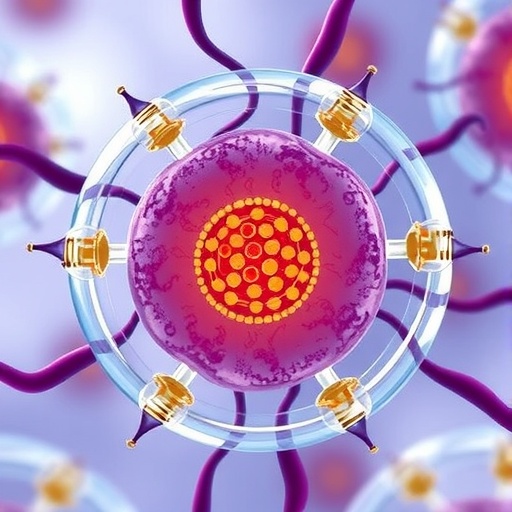Extracellular vesicles (EVs) represent a fascinating and ever-evolving component of intercellular communication in biological systems. These membrane-bound vesicles are secreted naturally by various cell types, delivering crucial signaling molecules and genetic material to neighboring or distant cells. What sets EVs apart is their complexity and functionality; they are not mere cellular debris but rather sophisticated vehicles capable of influencing numerous physiological and pathological processes.
Recent research has unveiled the multifaceted roles that tumor-derived extracellular vesicles play in cancer progression, particularly in the context of metastasis. The journey of cancer is intricately linked with the ability of tumor cells to invade surrounding tissues and establish secondary growths in distant organs—an endeavor that is closely aided by the EVs they release. These vesicles can carry oncogenic factors, enabling them to rewire the signaling pathways of recipient cells and facilitate invasive behavior, ultimately promoting the spread of tumors throughout the body.
The concept of pre-metastatic niches has gained significant attention. Tumor-derived EVs are known to contribute to this phenomenon by preparing distant sites for the arrival of circulating tumor cells. They achieve this by modulating the local microenvironment, enhancing immunosuppression, and reshaping the extracellular matrix. In essence, EVs act as messengers that inform other cells, including fibroblasts and endothelial cells, about the presence and intention of tumors, thereby enhancing the environments to nurture and sustain metastatic growth.
The intricate web of intercellular communication also comprises non-cancerous cell types. Tumor cells communicate not only with each other but also with surrounding stromal cells through EVs. Advanced studies reveal how cancer-associated fibroblasts and immune cells receive and interpret signals conveyed by tumor-derived EVs, further complicating the tumor microenvironment. This dynamic interaction can have detrimental effects on the effectiveness of immunotherapies and cancer treatments, indicating that targeting EVs may offer new avenues for intervention.
One particularly intriguing aspect of EVs is their role in modulating immune responses within the tumor microenvironment. T cells and other immune cells may be paralyzed or reprogrammed by the signals carried by EVs. As a result, tumor-derived EVs can promote an immunosuppressive microenvironment, helping tumors evade immune surveillance. In this context, understanding the mechanical properties of EVs becomes critical—how they are influenced by physical forces and how they exert their influence on recipient cells can substantially alter the course of tumor progression.
Mechanical forces play a significant role in shaping the biogenesis and functionality of EVs, thus linking the physical properties of the microenvironment to cellular behavior. These forces can dictate the size, composition, and release mechanisms of EVs, tailoring their cargo to suit specific biological contexts. For instance, increased tissue stiffness, which often accompanies tumorigenesis, can impact the release rates and molecular content of EVs, potentially enhancing their oncogenic repertoires.
Moreover, the intricate relation between mechanical cues and extracellular vesicle dynamics extends beyond just tumor biology. Studies indicate that mechanical stress can modulate EV activity in various physiological contexts, elucidating their potential roles in healing, regeneration, and even aging. By dissecting these mechanics, future research may uncover novel strategies to manipulate EV targeting and activity, potentially leading to therapeutic advancements in combatting cancer.
The ongoing exploration of this connection introduces a new paradigm where mechanobiology meets molecular signaling. This intersection offers the opportunity to develop innovative therapeutic approaches that could disrupt malignant communication pathways. Using engineered EVs to deliver therapeutics specifically to tumor sites or targeting EV release pathways represents a promising frontier in cancer treatment.
Looking forward, the evolving understanding of EVs holds promise for not only unraveling the complexities of tumor biology but also enhancing our therapeutic arsenal against cancer. The possibility of targeting EV-mediated communication or engineering them as delivery vehicles provides a yet untapped potential for precision medicine, allowing for tailored treatments that align closely with the mechanics of the tumor microenvironment.
As we move closer to the realization of these innovative therapies, continued investigation into the mechanics governing EV activity will be paramount. Each discovery sheds light on the potential to leverage EVs—be it for diagnosis, treatment, or understanding disease progression—signifying a monumental shift in how we approach not just cancer, but possibly other diseases characterized by similar intercellular communication networks.
In conclusion, the realm of extracellular vesicles in cancer is marred with complexities yet brimming with potential. Their dual roles as communicators and effectors in tumor progression highlight the necessity for integrated research approaches that encompass molecular biology and mechanical engineering. The quest for understanding how mechanical forces influence EV behavior, and consequently tumor dynamics, remains an essential pursuit that could redefine cancer therapy and patient outcomes profoundly. As we decode the intricacies of EVs further, we stand on the precipice of transformative discoveries that promise to reshape our understanding of cancer biology and therapy.
The elucidation of these mechanisms will not only catalyze breakthroughs in the realm of oncological therapies but may also refine our approaches to other diseases where EVs have been implicated. As researchers delve deeper into the mechanics of EVs, the future of cancer treatment looks increasingly promising, empowering new insights and applications that could save innumerable lives. The role of extracellular vesicles in cancer progression ultimately underscores the intricate connection between mechanical forces and biological signaling, paving the way for a new era in precision medicine and targeted therapy.
Subject of Research: The role of extracellular vesicles in cancer progression and their mechanical regulation.
Article Title: Mechanical regulation of extracellular vesicle activity during tumour progression.
Article References:
Parihar, K., Liu, DA., Hassan, G. et al. Mechanical regulation of extracellular vesicle activity during tumour progression.
Nat. Biomed. Eng 9, 1202–1221 (2025). https://doi.org/10.1038/s41551-025-01446-0
Image Credits: AI Generated
DOI: https://doi.org/10.1038/s41551-025-01446-0
Keywords: Extracellular vesicles, cancer progression, metastasis, tumor microenvironment, intercellular communication, mechanical forces.
Tags: extracellular matrix remodeling by EVsextracellular vesicles in cancerimmunosuppression and EVsimpact of EVs on tumor microenvironmentintercellular communication in tumorsmechanical control of EVsoncogenic factors in extracellular vesiclespre-metastatic niches in cancerroles of EVs in metastasissignaling pathways influenced by EVstherapeutic implications of EVs in cancertumor-derived vesicles





